
|   |

|   |
Kala Nadam Festival 2015 - Prabal Gupta e-mail: probs.gupta12@gmail.com Photos courtesy: Nadam December 11, 2015 If ever the dance festivals of Bangalore are rated, the Kala Nadam festival and Noopura's Nitya Nritya festival will definitely occupy the first ranks for avoiding any partiality and inviting brilliant artists without showcasing any favouritism by repeating the same artists every year. This year the Kala Nadam festival (Nov 27 - 29, 2015) invited artists from variegated arena of Indian classical dances sans Kathakali, Manipuri and Sattriya. 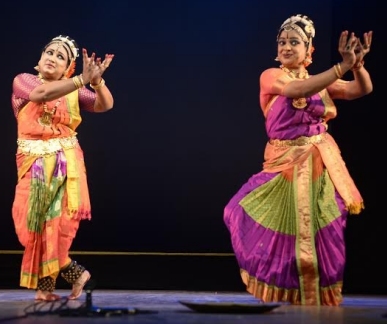 Deepa Sashidharan and Rekha Satish Day 1 commenced with a Kuchipudi duet by Deepa Sashidharan and Rekha Satish. Trained under great stalwarts of Kuchipudi like Guru Manju Bhargavee and Guru Vempati Ravi, they commenced their recital with a Ganapati Stuti "paripahi ganadhipa bha sura mu" set to raag Saveri and adi talam. Allegiance and premeditated practice surfaced in this duo's performance right from the beginning. Presenting authentic Kuchipudi to the rasikas of Bangalore was definitely a pleasure to watch. The alternate movements, neat charis by both the dancers appeared consummate. The Tarangam from the Krishna Leela Tarangini set to Ragamalika in adi tala composed by the saint Narayana Teertha choreographed by Vempati Ravi spoke about the duo's perseverance with no hitch while performing on the brass plate. Graceful and lyrical movements, neat and restrained attami looked poised. They concluded with Vempati Ravi's choreography "Vande Vasudevan" propitiating Lord Vishnu composed in the 16th century by the poet Saint Annamacharya. 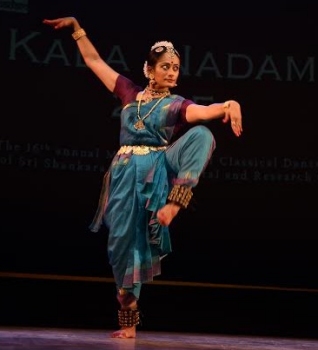 Anuradha Venkatraman Anuradha Venkatraman, a disciple of Saroja Vaidyanathan, commenced her Bharatanatyam recital with an alarippu set to khandam and mishra talam. The neat kuddittas during the Swati Tirunal varnam "Dani Swamajendra gamini" with the khandita nayika pining to unite with her lord Padmanabhaswamy residing in his abode in the Thiruvananthapuram Padmanabhaswamy temple showed the dancer's feel for rhythm and sahitya. Her neat abhinaya coupled with chiseled fine araimandis, circumnavigating the proscenium in neat kudittas set to the jathis "jhanu tat tom", Tak kita naam" called for an immaculate performance. Deepti Srinath's soulful rendition of Tulsidas's Adbhuta Ramayana propitiating Sita as a creator, preserver and destroyer with the dancer ornamenting it beautifully through her dance brought a suitable end to her recital. 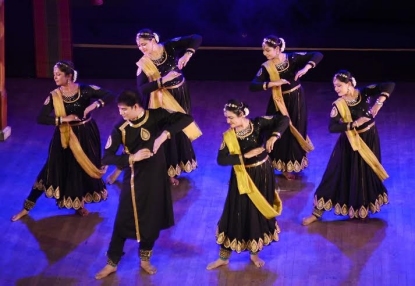 Nadam ensemble The evening concluded with a vibrant Kathak recital by the Nadam Ensemble. Commencing their recital with "Sirisha Karna" initially choreographed by Pt. Sundarlal Gangani, the dancers moved onto a technical "Jhaap Taal" of 10 beats. A beautiful formation by dancers Poorna Acharya, Smitha Srinivasan, Samanvita Sharma and Arpita Banerjee using the stage geometry was of high aesthetic fervor. The Meera Bhajan with an aesthetic stage setting and the Tarana beautifully choreographed by Nandini and Murali, made for a magnificent performance.  Rama Venugopal On day 2, Rama Venugopal's Bharatanatyam started on a poetic note. The Dandayudhapani Pillai varnam "Swamiyai azaithodi vaa' with chiseled fine lines and articulated araimandis during the implementation of the jathis spoke of the dancer's commitment to her art. The interpretative passages were embroidered with the procession of the presiding deity of Chidambaram with bull, elephants and nadaswaram. The interpretation of the sahitya interspersed with neat nritta segments, the micro and macro mingling and understanding that the Lord whom she is pining for resides within her was extremely well handled. Vasudha's evocative singing further embellished the dancer's performance. 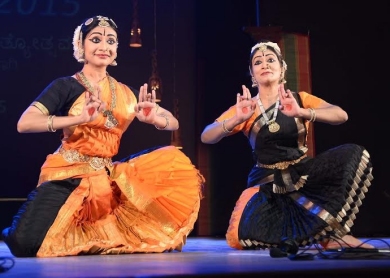 Neelamana sisters The Bharatanatyam / Kuchipudi duet by the Neelamana sisters remained understated. The Kathak duet by Nandini Mehta and Murali Mohan Kalva commenced with "Bho Sambho." The production initially launched as a jugalbandi with Bharatanatyam in 2002 was performed beautifully as a Kathak duet this year. This was followed with neat and energetic execution of tat, amad, paran and tatkars through a tala cycle of 16 beats. The recitation of bols by both Nandini and Murali was amidst prerecorded music. It is obligatory for me to mention as a connoisseur that ludicrous whistling and making cheap, weird sounds by fan followers amidst any classical dance or music concert series is not in good taste. 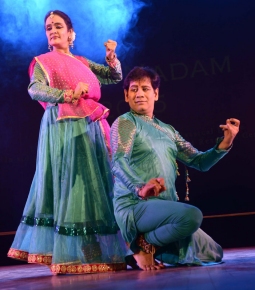 Nandini Mehta and Murali Mohan Kalva On day 3, Vishal Krishna's performance commenced with a Shiva Stuti. The initial part of his performance was missed by this writer because of the torrential rain in Bangalore. However, watching the performance of his tatkar on a brass plate following the legacy of his grand aunt Sitara Devi calls for applause. Vishal concluded with an abhinaya piece - an excerpt of Tulsidas' Ramcharit Manas "Thumak chalat Ramachandra." However, three special performances for the Kala Nadam festival 2015 which stole everyone's heart were Pallavi Krishnan's Mohiniattam on Day 1, Sujata Mohapatra's Odissi recital on Day 2 and Nadrup's mesmerizing Kathak recital on the concluding day of the festival. 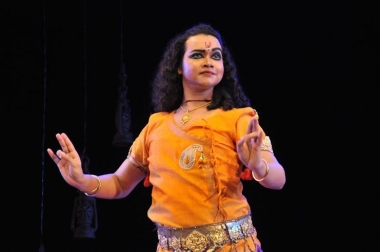 Vishal Krishna 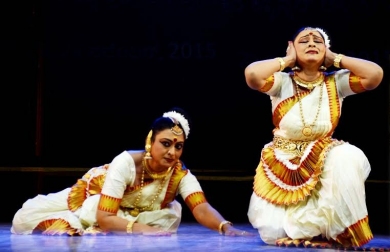 Pallavi Krishnan Pallavi Krishnan commenced her recital with a self choreographed Cholkettu set to raag Kedargowla and Hamirkalyani in adi and tisra talam composed by Palakkad Surya Narayanan. Tastefully costumed, the dancer’s zest for the dance form surfaced right from the beginning. The sloka “Ya kundendu tushara” propitiating Goddess Saraswati with the dancer’s beautiful swaying of the torso forming the 8 structure so congruous to the genre of Mohiniattam while delineating the veena through her angika abhinaya looked visually appealing. Beautiful juxtaposing of the syllables “Tam tam kita tom, taka tadhikina tom” sounded melodious with the accompaniment of the maddalam, edakkya and the veena. The Ragamalika Shiva Tatvam set to Sopanam music by Kavalam Narayana Panikker in panchari talam accompanied with quality prerecorded sound tape defining a clear indication of the Kerala percussion ensemble called for an authentic Mohiniattam recital. Perfect iratti with the dancer forming rectangles touching upon its four corners, perfect chuzipoos exhibiting conscious practice of the exercises appropriate to Mohiniattam and Kathakali over her years of training indicated the dancer’s brilliant artistry. Usage of the vaittaris so concomitant to the Kerala tala system was appealing. Pallavi concluded with Pingala - a story of a concubine. Skillfully delineating the crux of the story that beauty dilapidates with the passage of time and the odalisque’s micro macro mingling with the supreme Lord Rama was moving. 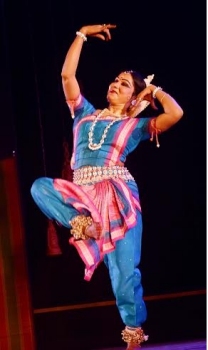 Sujata Mohapatra If ever a person wishes to compose a poem, one must watch Sujata Mohapatra's Odissi recital for the form to metamorphose into a poem in the hands of this gifted dancer. Though presenting only Guru Kelucharan Mohapatra and her husband's choreography sans her own, one must curtsy her zest in giving a new dimension of high aesthetic order to the choreographies which she proficiently executes. Commencing her recital with a Guru Vandana choreographed by Ratikant Mohapatra, the dancer moved on to the Pallavi set to raag Bhageshree in ek taal. With the music composed by Raghunath Panigrahi, the dancer established a beautiful jugmadanda with the music, the vocalist and the pakhawaj. Pivoting her cervical spine maintaining at an angle of ninety degrees, the body beautifully created the bamachala and the dakhachala. The ‘S' curve as created during the asymmetrical tribhangi with the beautiful permutation and combination of chowkas, abhanga and tribhanga proved the dancer's grit on the minute nritta technicalities. Her framing of neat movements, the perfect angika abhinaya of Odissi calls for her perseverance through years of resolute practice. The 30 minute "Sita Haran" episode in Oriya choreographed by Guru Kelucharan Mohapatra enthralled the aficionados. Sujata sensitively rendered the characterization brilliantly switching over roles from male to female with concomitant actions and reached the zenith of her abhinaya when she characterized Ravana. In the subsequent Jatayu episode, Sujata's portrayal of Jatayu was aesthetically executed with minute subtlety. 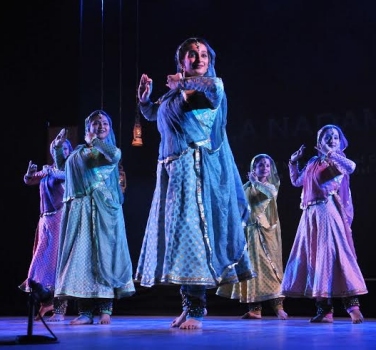 Nadroop The festival concluded with a brilliant and a vibrant Kathak recital by Nadroop under the direction of Shama Bhate. Titled "Sarangsh", Nadroop commenced their recital with a Shiva stuti interspersed with Natesha Kauthuvam, beautiful flow of syllables voiced by Satish Krishnamurthy, with the dancers moving in tandem deftly weaving beautiful formations on stage. Neat and vibrant tatkars embroidered the piece. The laya sopana inspired by the Sopana Sangeetam genre with the music starting in slow crescendo gradually reached its zenith with three dancers beautifully interacting with each other on the proscenium. However, the two pieces de resistance were compositions based on German language bringing forth Shama Bhate's intense depth in creativity and choreography along with the acceptance of a wider spectrum of languages to suit her dance form. The first one was the dramatic conversation between a son and a father. Son is scared to traverse through the jungle, but the father's persistent negating brought a poignant end to the life of the young child. Helmut Scholeitner's composition of the second piece portraying a jugalbandi of Kathak with contemporary music choreographed by Shama Bhate was appealing and concluded aesthetically with ‘Chaturang' based on Krishna. Set to raag Desh, this brilliant choreography brought out the beautiful curvature of the body of Krishna, the curves or the ripples as created by the wind on river Yamuna and the curves of Radha's veil. Prabal Gupta is a Kathakali exponent and a disciple of Guru and research scholar Sadanam Balakrishnan. He is the recipient of the Young Achiever's Award 2015 conferred on him by the Tagore Cultural Association, Bangalore for his contribution in the field of Kathakali. |